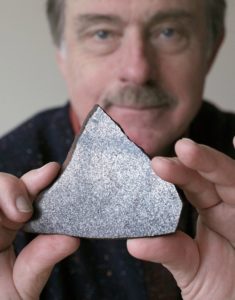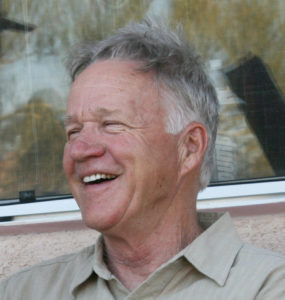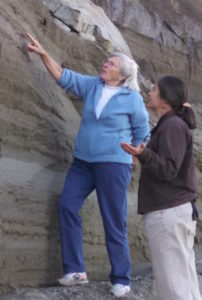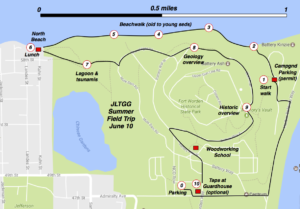About the Talk
Meteorites—Exotic Fragments of Other Planets and Asteroids
Meteorites are extraterrestrial rocks or metal-rich objects that fall onto our planet. Sometimes those that survive entry through our atmosphere are found and analyzed. However, until 1492 when the Ensisheim meteorite was seen falling to Earth in France, the idea of rocks from space was not accepted. Since then and especially over the past 20 years, this field of study (meteoritics) has grown significantly due in large part to the recovery of many new specimens, especially from the barren deserts of Northern Africa. Meteorite samples can be quite valuable as collector items.
Dr. Irving’s presentation will describe how research on meteorites is conducted and how the results have greatly expanded our knowledge of the history of the Moon, Mars, and bodies within the Asteroid Belt between Mars and Jupiter.
 About the Speakers
About the Speakers
Tony Irving, UW professor and world expert on meteorites, holds one of his meteorite samples that have been dated at 4.6 billion years. He is an international expert in meteorites, having identified more than 1500 samples from Northwest Africa, Oman, China and the USA and published over 90 articles in international journals and books. He received his B.Sc. and Ph.D. degrees in Australia.
 In addition to Tony’s lecture, local meteorite collector Eric Twelker will be on hand to display some samples of meteorites from his extensive collection. Eric Twelker of Port Townsend has been a lawyer, organic farmer, and geologist. However, his passion has been meteorites. Eric’s online business, the MeteoriteMarket.com, is twenty-two years old and was the first meteorite catalog available on the internet in 1995.
In addition to Tony’s lecture, local meteorite collector Eric Twelker will be on hand to display some samples of meteorites from his extensive collection. Eric Twelker of Port Townsend has been a lawyer, organic farmer, and geologist. However, his passion has been meteorites. Eric’s online business, the MeteoriteMarket.com, is twenty-two years old and was the first meteorite catalog available on the internet in 1995.

 The San Juan Islands record geologic growth of the western edge of North America by very active plate tectonics, which added exotic terranes ~400 to 100 million years ago. These terranes came from distant origins—Asia, Greenland, and the ancestral Pacific Ocean. The terranes moved through the ocean realm; they accreted by subduction at the continental edge, perhaps in N. California, at depths of 20-30 kilometers or more. These old rocks were then exhumed and transported north in a “forearc sliver” along the continental margin. They eventually collided with and stacked up on the south-facing edge of Wrangellia (Vancouver Island) and on the south end of the active Coast Plutonic Complex (a magmatic arc). At this point in San Juan Islands evolution, ~ 100 million years ago, the major tectonic elements were pretty much as they are now: The Islands were composed of stacked thrust sheets on the southeast edge of Wrangellia, and major plutonism emplacing younger rocks in the southern B.C. Coast Mountains.
The San Juan Islands record geologic growth of the western edge of North America by very active plate tectonics, which added exotic terranes ~400 to 100 million years ago. These terranes came from distant origins—Asia, Greenland, and the ancestral Pacific Ocean. The terranes moved through the ocean realm; they accreted by subduction at the continental edge, perhaps in N. California, at depths of 20-30 kilometers or more. These old rocks were then exhumed and transported north in a “forearc sliver” along the continental margin. They eventually collided with and stacked up on the south-facing edge of Wrangellia (Vancouver Island) and on the south end of the active Coast Plutonic Complex (a magmatic arc). At this point in San Juan Islands evolution, ~ 100 million years ago, the major tectonic elements were pretty much as they are now: The Islands were composed of stacked thrust sheets on the southeast edge of Wrangellia, and major plutonism emplacing younger rocks in the southern B.C. Coast Mountains. About the Speaker
About the Speaker
